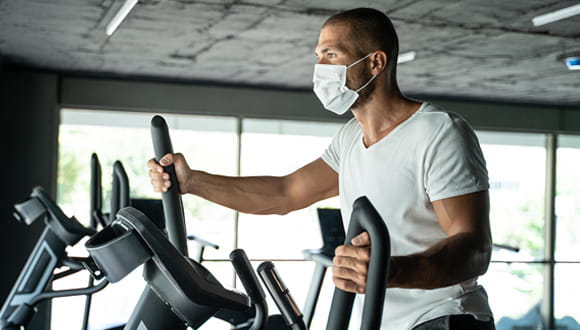COVID-19: Is It Safe to Go Back to the Gym?
June 11, 2021 - Katie McCallumEven before the COVID-19 pandemic began, you probably wondered whether or not you should be worried about germs at the gym.
After more than a year of wearing masks and using copious amounts of hand sanitizer and more disinfectant wipes than you can count, it's probably all you can think about when considering heading back to the gym.
If you're fully vaccinated, it means you're more protected from COVID-19 — which provides some flexibility in regard to what you can feel safe doing again. However, you may also make the personal decision to continue to be cautious by continuing at-home or outdoor workouts.
Plus, even if you're fully vaccinated, experts at Houston Methodist recommend continuing to wear a mask and social distance at the gym or during an exercise class.
If you're not vaccinated, working out at home is still the safer alternative. However, if you do go back to the gym, do be sure to take extra precautions. In addition, know that the CDC states that participating in an indoor, high intensity exercise class is very risky.
Vaccinated or not, if you're considering heading back into the gym or attending an exercise class, here are six ways to best protect your health, as well as the health of your fellow gym-goers and loved ones.
Avoid your gym's peak hours
COVID-19 primarily spreads from person-to-person through respiratory droplets. This means that one of the best ways to avoid getting sick is through social distancing, which includes avoiding crowds.
The best way to reduce your chance of coming into contact with someone who may have COVID-19 while at the gym is to go during times when the fewest number of people are there.
If you don't know your gym's peak hours, call them and ask. In addition, some smartphone map apps list a location's popular times, as well as whether or not it's currently busy.
Avoid areas with crowded equipment
Social distancing also means avoiding close contact with other people. Keep in mind, "close" may actually be farther apart than you initially thought.
To protect yourself from COVID-19, the CDC recommends keeping six feet between yourself and others.
This means you'll want to use the equipment that gives you ample space between yourself and other gym-goers — which can be hard to do at times. And, if you're unvaccinated, keep in mind that the CDC does not recommend attending an indoor, high intensity exercise class.
Wipe down every piece of equipment you use
Evidence suggests that the new coronavirus can live on surfaces anywhere from a few hours to several days. This means it's important to clean and disinfect each piece of equipment you use.
Chances are that most gyms are already stepping up their disinfection practices — but don't be afraid to duplicate their work. Before and after using a piece of equipment, be sure to wipe it down with plenty of disinfectant.
If you're unvaccinated, you may also consider avoiding the pieces of equipment that are the most commonly used, such as barbells, dumbbells, treadmills, elliptical trainers and yoga and stretch mats — especially if they seem hard to clean and wipe down.
Wash your hands and avoid touching your face
Before and after your workout, be sure to practice proper hand washing. You may also want to consider using hand sanitizer periodically throughout your workout.
Lastly, although it can be hard to do while you're sweating, avoid touching your face — particularly your eyes, nose and mouth. These are three main entry points for respiratory viruses like the new coronavirus.
Stay home if you're sick
As with any infectious illness, it's recommended that you stay home as much as possible if you suspect you're sick — even if you're vaccinated.
The common symptoms of COVID-19 include:
- Coughing
- Fever
- Shortness of breath
Even if your symptoms are mild, stay home. You're most contagious while experiencing symptoms. While you may only have mild illness, others are at risk for developing a more severe, potentially life-threatening case of COVID-19.
Consider working out at home
Whether you're vaccinated or not, keep an eye on community spread in your area. If it's increasing, you may want to consider forgoing the gym and working out at home. There are plenty of body weight exercises you can do without any equipment at all, as well as free workout videos to guide your home workout routine.
Concerned you may have COVID-19?
- If you're experiencing COVID-19 symptoms, you can speak to a Virtual Urgent Care provider. The provider will help you determine if testing is needed and advise you on where you should go.


